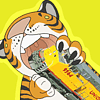
Cab Forward 4275 pushes at the rear to help 4015 up the grade.
Category Photography / All
Species Unspecified / Any
Size 1280 x 640px
File Size 140.1 kB
Back then they just pushed. It took real skill to operate a helper locomotive and not bind or bend up the train on curves and grades. In the early days the only real synchronization between the head and hind ends was via whistle and hand signals and the competence of the engineers. Later on with the advent of radio, communication was greatly advanced and the operations became much safer. Today with computers we commonly run trains with unnamed DPUs which are electronically linked to one operating unit. This allows for more precise locomotive usage.
that background almost looks like yuba gap. incidentally, the helpers on the hill (donner summit) were 'mid trained', one 40 cars back from the head end, and the second 20 cars AHEAD of the caboose.
(i lived at norden on donner summit where my dad worked the tower/station there. where they were cut out and sent back down the hill to roseville (where i live now)).
and yes, those big square tenders behind the 4200's caried a HUGE amound of oil. sp did like vanderbelt tenders for smaller steam, and used wagon top tenders with some of the earlier cab forwards, but from class ac-7 onward, possibly earlier, i'm no authority on this, by the time i was born there were only class 9-12 in service, they went to the largest highest capacity they could.
they did this with the diesels they replaced them with too. replacing emd, and alco's more typical fuel tanks, with the largest ones they could fit. more fuel capacity = fewer refuelings = lower labour cost, not to mention the distance over the hill from roseville to sparks, or across the great basin from sparks to carlin and carlin to ogden.
(i lived at norden on donner summit where my dad worked the tower/station there. where they were cut out and sent back down the hill to roseville (where i live now)).
and yes, those big square tenders behind the 4200's caried a HUGE amound of oil. sp did like vanderbelt tenders for smaller steam, and used wagon top tenders with some of the earlier cab forwards, but from class ac-7 onward, possibly earlier, i'm no authority on this, by the time i was born there were only class 9-12 in service, they went to the largest highest capacity they could.
they did this with the diesels they replaced them with too. replacing emd, and alco's more typical fuel tanks, with the largest ones they could fit. more fuel capacity = fewer refuelings = lower labour cost, not to mention the distance over the hill from roseville to sparks, or across the great basin from sparks to carlin and carlin to ogden.
oh and i forgot to mention, (freight) trains on the hill WERE typically LONGER then 100 cars. an 80 car train was considered short (and short enough to need only one helper instead of the more usual two). sp also didn't like pushing against the caboose. even an end of train helper would be cut in ahead of it.

 FA+
FA+















Comments